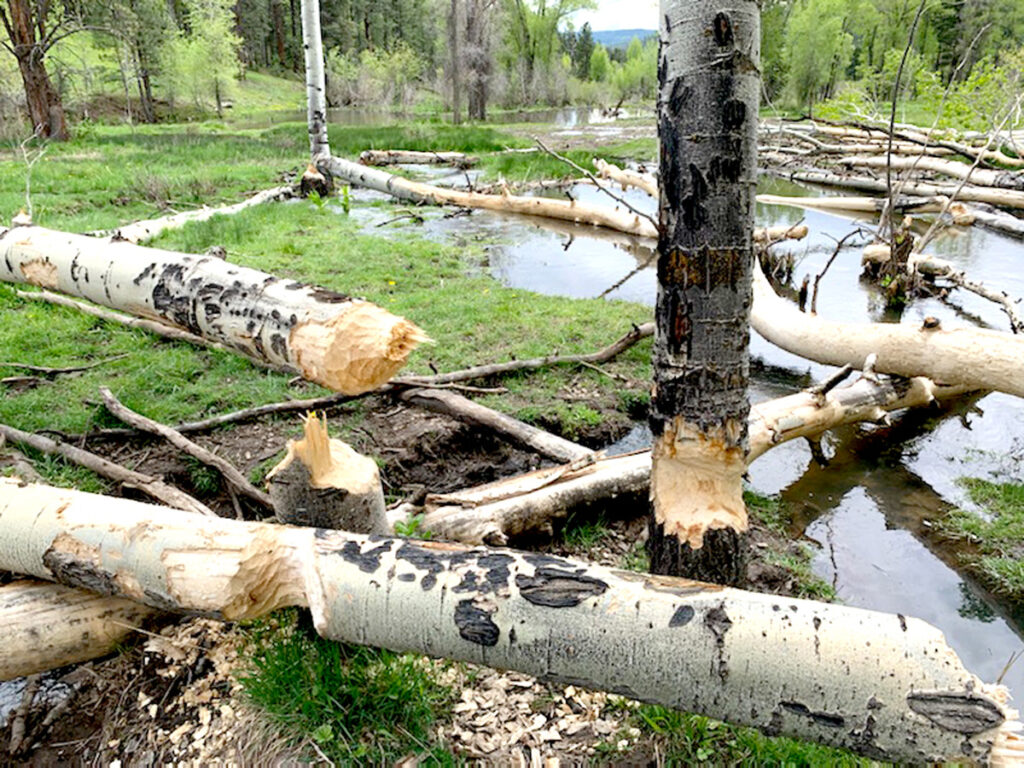
The beaver is what is known as a keystone species, an organism that can shape or define an ecosystem with its behavior and habits. There is a beautiful diversity of creatures that serve a keystone function, from elephants to bees.
Wolves, for example—by forcing herds of grazing animals to keep moving from fear of being eaten—enable grass growth and promote lush streamside vegetation. Otters, a recent concern of Questa fishermen, appear to prefer eating crayfish, carp, and pike, prey that are detrimental to trout (crayfish eat trout eggs and newborns) and easier for otters to catch. Perhaps a result of otter impact on these species, trout populations in the Rio Grande appear to be increasing.
The keystone species we’re most familiar with is ourselves. Humans affect ecosystems in many profound ways, overconsuming carbon-based fuels, for example, even staring obliviously at cell phones.
Beavers make messes for a living. They cut down trees and leave them all over the place. They eat some of the trees, mainly the bark, and as we all know, they use wood and logs to dam up streams and spread water. Understandably, beavers’ tree cutting and flooding have won them no shortage of enemies among farmers and homeowners, particularly folks who build houses too close to streams and rivers.
But even the thinnest tortilla has two sides, something we should keep in mind when pondering the origin of our rural communities in the first place. Take the gently sloping lowlands and fields around the junta of the Red River and Cabresto Creek. That this area is suitable for farming is testimony to centuries of human populations bending nature to their need for food and other materials.
Previous and parallel to human occupation, beavers were working, too. Erosion, including extreme events such as post-fire debris flows, accounts for almost all of the valley’s abundant fertile soil in our watershed, but what kept it from washing away?
Beavers did! Through a process repeated throughout North America, chewed-down trees and beaver dams strewn across the valley trapped eroded material. Over time, each mess got buried and a new one was made on top of it. With their dams, beavers not only lifted water tables and captured sediment, they enabled small-scale agriculture in northern New Mexico.
In the late 1800s, when we declared open season on the nation’s natural resources, beavers were among the worst casualties. Trapping promised big money, especially for beavers but it reduced beaver populations from more than a billion to just thousands. No longer stabilized by interconnected beaver networks, rivers paid the price, unnaturally straightening, flowing high one day and low the next. Once serving as firebreaks, water purifiers, food pantries, and maintainers of groundwater levels, stream systems became diminished and weak.
The Galisteo River, Rios Puerco, Gallina, and San Jose; these New Mexico streams once reached larger rivers, but now are merely ghosts that only come out when it rains hard.
Beavers were still around then, when the stream beds were up here instead of down there, when the cottonwoods grew, and willow flycatchers flew… when the water flowed out of the ground instead of into it. We’ve learned a lot about beavers in recent years, most of it helpful, particularly in these times of biting drought, low stream flows, and worsening erosion.
Addressing our problems will require more than just money. We need good ideas, and beavers are—and always have been—the best idea there is for fixing rivers. Plus, they work for free.




